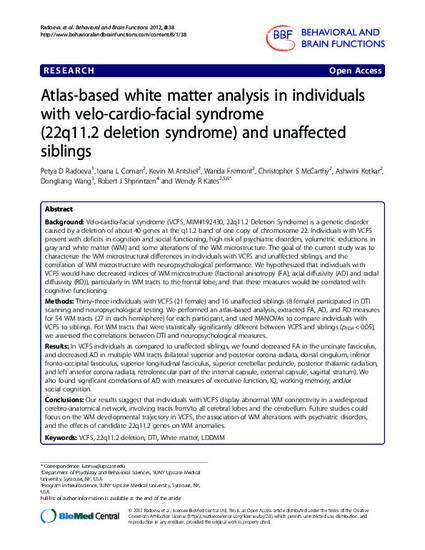
Background: Velo-cardio-facial syndrome (VCFS, MIM#192430, 22q11.2 Deletion Syndrome) is a genetic disorder caused by a deletion of about 40 genes at the q11.2 band of one copy of chromosome 22. Individuals with VCFS present with deficits in cognition and social functioning, high risk of psychiatric disorders, volumetric reductions in gray and white matter (WM) and some alterations of the WM microstructure. The goal of the current study was to characterize the WM microstructural differences in individuals with VCFS and unaffected siblings, and the correlation of WM microstructure with neuropsychological performance. We hypothesized that individuals with VCFS would have decreased indices of WM microstructure (fractional anisotropy (FA), axial diffusivity (AD) and radial diffusivity (RD)), particularly in WM tracts to the frontal lobe, and that these measures would be correlated with cognitive functioning.
Methods: Thirty-three individuals with VCFS (21 female) and 16 unaffected siblings (8 female) participated in DTI scanning and neuropsychological testing. We performed an atlas-based analysis, extracted FA, AD, and RD measures for 54 WM tracts (27 in each hemisphere) for each participant, and used MANOVAs to compare individuals with VCFS to siblings. For WM tracts that were statistically significantly different between VCFS and siblings (pFDR < 0.05), we assessed the correlations between DTI and neuropsychological measures.
Results: In VCFS individuals as compared to unaffected siblings, we found decreased FA in the uncinate fasciculus, and decreased AD in multiple WM tracts (bilateral superior and posterior corona radiata, dorsal cingulum, inferior fronto-occipital fasciculus, superior longitudinal fasciculus, superior cerebellar peduncle, posterior thalamic radiation, and left anterior corona radiata, retrolenticular part of the internal capsule, external capsule, sagittal stratum). We also found significant correlations of AD with measures of executive function, IQ, working memory, and/or social cognition.
Conclusions: Our results suggest that individuals with VCFS display abnormal WM connectivity in a widespread cerebro-anatomical network, involving tracts from/to all cerebral lobes and the cerebellum. Future studies could focus on the WM developmental trajectory in VCFS, the association of WM alterations with psychiatric disorders, and the effects of candidate 22q11.2 genes on WM anomalies.
Radoeva, P. D., Coman, I. L., Antshel, K. M., Fremont, W., McCarthy, C., Kotkar, A., Wang, D., Shprintzen, R. J., & Kates, W. R. (2012). Atlas-based white matter analysis in individuals with velo-cardio-facial syndrome (22q11.2 deletion syndrome) and unaffected siblings. Behavioral and Brain Functions, 8(38), 1-11.

At the time of publication Robert J. Shprintzen was affiliated with The Virtual Center for Velo-Cardio-Facial Syndrome, Manlius, NY. He is also an adjunct professor at Sacred Heart University.